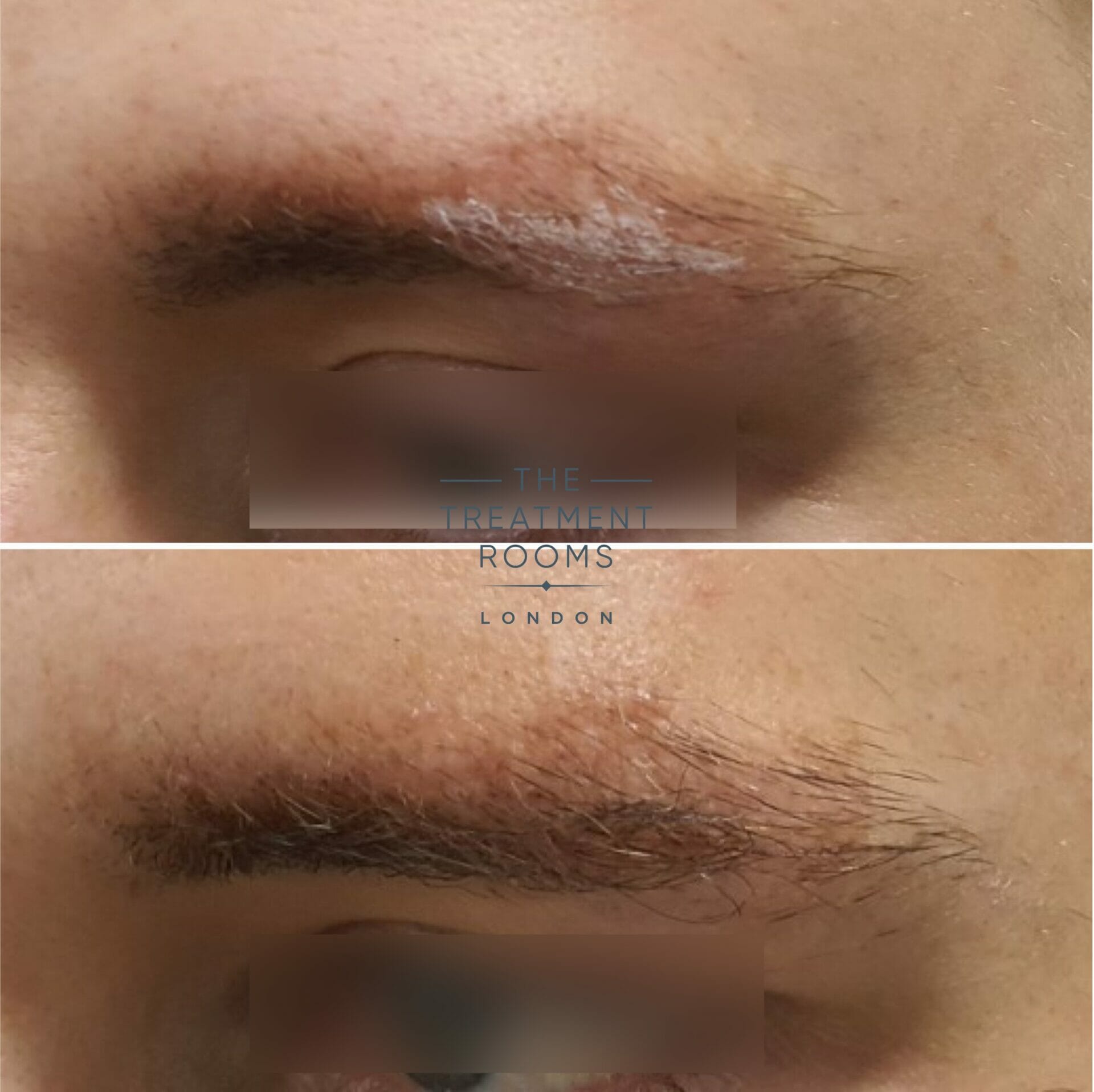How Does An Eyebrow Hair Transplant Work?
Have you ever considered an eyebrow hair transplant? Missing eyebrow hair can be permanently corrected through this procedure, which is suitable for people who suffer from sparse eyebrows or thinning eyebrow hair. If you are in need of eyebrow restoration, an eyebrow hair transplant can offer a more natural look than alternative techniques like microblading or tattooing.
What is an eyebrow hair transplant?
Some people suffer from missing or thinning eyebrows. This can stem from a number of causes, such as genetics, ageing, scarring, burns or over-plucking. If this applies to you, an eyebrow hair transplant may be a good option.
At The Treatment Rooms London, we use the revolutionary follicular unit extraction (FUE) technique to rebuild thinning or damaged eyebrows, giving you a more natural look. This is a delicate, micro-surgical procedure which requires no stitching or major incisions. It takes healthy hair follicles from the back of the scalp and transplants them into thinning areas of the eyebrows, creating a new, natural look for people with thinning or damaged eyebrows.

How does an eyebrow hair transplant work?
An eyebrow hair transplant is a minimally-invasive procedure that will be completed in one day. It will be performed in an operating room at your hair transplant clinic, and you will be able to return home the same day.
The FUE technique for eyebrows is similar to the FUE procedure for hairline or crown transplants. Donor hair will be taken from an area of your scalp (usually the back of the head). The donor hair is extracted as individual hair follicles using tiny punches with a hypodermic needle. The procedure is carried out under local anaesthetic, and you should not feel any discomfort after the anaesthetic has been given. The single follicular units are then implanted into tiny incisions which have been prepared in the thinning areas of your eyebrows.
Who is eligible for an eyebrow hair transplant?
You may be a good candidate for an eyebrow transplant if you:
- Are losing your eyebrow hair due to genetics or ageing
- Have a scar in the eyebrow area
- Have been over-plucking
- Have burns
There are reasons that you may not be a good candidate for an eyebrow hair transplant, such as if you have trichotillomania (a condition which involves the habit of pulling out your hair) or alopecia areata (a disease which involves the immune system attacking hair follicles, causing hair loss).
Eyebrow hair transplant recovery and aftercare
Taking all necessary aftercare steps is essential to getting the best results from your eyebrow hair transplant. In the hours following the procedure, it is important that you don’t touch your eyebrows in order to reduce the risk of infection. You’ll be given a saline follicle spray to promote healing. Once 4 days have passed, you can wash your face and eyebrows with shampoo. You should take great care not to rub your eyebrows dry, but only to gently pat them.
After around three to seven days, the crusts that had formed on your eyebrows will begin to fall off, and you may see some redness on the area underneath. Avoid sun exposure for the first month after your eyebrow hair transplant if possible.
Your transplanted hairs will fall out after a few weeks, this is called ‘shedding’ and it’s a normal part of the recovery process. Once the hairs fall out, your new eyebrow hair will start to grow in its place.
Eyebrow transplant vs microblading
Microblading might appeal to some as an alternative to an eyebrow hair transplant. This is a cosmetic procedure which involves tiny lines being drawn by hand and filled with pigment, giving them the look of individual hairs.
If you are weighing up the pros and cons of microblading compared to an eyebrow hair transplant, it is important to note that microblading is only a temporary solution to sparse eyebrows, and that the procedure will need to be refreshed as frequently as once a year. Results are also inferior to an eyebrow hair transplant, as microblading does not use real hair.
Before and after eyebrow transplant
There are many reasons why eyebrow hair transplants have rocketed in popularity in recent years. The accuracy of the procedure, facilitated by a high magnification microscope, enables the ideal placement of hairs and the mimicking of natural growth thanks to subtle variations in direction. This procedure gives you the gift of regaining eyebrow growth. Not only will your eyebrows look denser, but the natural-looking final outcome means that you won’t display obvious signs of having undergone surgery.
Results from an eyebrow hair transplant are permanent. Growth will become more noticeable at four to six months after the surgery, and the final cosmetic result can be expected at 10-12 months.

Eyebrow transplant side effects
A degree of bruising or swelling is normal after the procedure and should subside in a few days. Serious side effects from an eyebrow hair transplant are rare. The FUE technique involves no major incisions and uses no scalpels. However, as with any form of surgery, there is a small risk of potential side effects such as:
- Excessive bleeding
- Scarring
- Nerve damage
If you suffer from any of the above side effects, it’s important to get in touch with your eyebrow transplant surgeon as soon as possible.
Get in touch
You can expect an eyebrow hair transplant to cost in the region of £3,000 to £5,000, depending on the number of grafts needed. Having your eyebrow transplant at The Treatment Rooms London assures you of highly experienced, specialised surgeons, as well as a completely personalised care package including consultations and aftercare.
Discover more about eyebrow hair transplants at The Treatment Rooms London – call us on 020 8706 0076 or use the contact form
Book A Consultation
